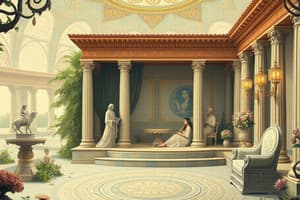Podcast
Questions and Answers
The Etruscans lived in the area known as _____
The Etruscans lived in the area known as _____
Etruria
Etruscans had a strong belief in _____
Etruscans had a strong belief in _____
fate
The Etruscans made sculptures in all of the following materials except _____
The Etruscans made sculptures in all of the following materials except _____
- Terracotta
- Bronze
- Wood
- Marble (correct)
The Etruscan civilization is considered to be the forerunner of _____
The Etruscan civilization is considered to be the forerunner of _____
Etruscan sculpture often incorporated mythological creatures.
Etruscan sculpture often incorporated mythological creatures.
The Etruscans' sculpture of human forms tended to show intricately, fully detailed torsos from head to toe.
The Etruscans' sculpture of human forms tended to show intricately, fully detailed torsos from head to toe.
The Etruscans were isolated from other cultures.
The Etruscans were isolated from other cultures.
Every level of Etruscan society had frescoes on their tombs.
Every level of Etruscan society had frescoes on their tombs.
Etruscan painting was highly developed and used pigments created from stone and minerals.
Etruscan painting was highly developed and used pigments created from stone and minerals.
Flashcards are hidden until you start studying
Study Notes
Etruscan Civilization Overview
- The Etruscans inhabited the region known as Etruria in ancient Italy.
- Etruscan civilization is recognized as a precursor to the Roman civilization.
Beliefs and Society
- Etruscans held a strong belief in fate, influencing their culture and practices.
- Artistic representation in Etruscan society reflected a comprehensive view of the afterlife and mythology.
Sculpture and Art
- Etruscan sculptures were made from various materials, notably excluding marble.
- Mythological creatures frequently featured in Etruscan art, showcasing their intricate beliefs.
Art Techniques
- Etruscan painting utilized pigments derived from natural stones and minerals, displaying advanced artistic skills.
Characteristics of Etruscan Sculpture
- Unlike the depiction of human forms in other civilizations, Etruscan sculptures did not typically exhibit detailed torsos from head to toe.
Cultural Interactions
- The Etruscans were not isolated; they interacted with surrounding cultures, which influenced their artistic styles.
Tomb Art and Frescoes
- Not all levels of Etruscan society had frescoes on their tombs, indicating a distinction in burial practices among social classes.
Studying That Suits You
Use AI to generate personalized quizzes and flashcards to suit your learning preferences.




